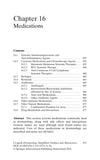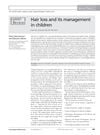Successful Management of Netherton Syndrome Using IVIG and Dupilumab: A Case Report
April 2025
TLDR IVIG and dupilumab effectively improved symptoms in a child with Netherton syndrome.
This case report details the successful management of Netherton syndrome (NS) in a 7-month-old Saudi boy using intravenous immunoglobulin (IVIG) and dupilumab. The patient, who had a confirmed SPINK5 gene mutation, experienced severe skin symptoms and frequent infections. IVIG therapy was initiated at 18 months to address infections, and dupilumab was added at age 6 to reduce inflammation and improve skin barrier function. The combined treatment led to significant clinical improvements, including reduced pruritus, better sleep, enhanced quality of life, and notable hair growth. Additionally, serum IgE levels decreased significantly, indicating improved immune regulation. This case highlights the potential of IVIG and dupilumab in managing NS effectively.



